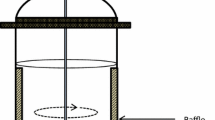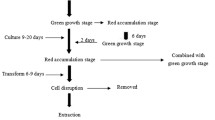Abstract.
A perfusion–cell bleeding culture strategy was developed for enhancing the productivity of eicosapentaenoic acid (EPA) by the diatom Nitzschia laevis. As the strategy combined the concepts of continuous culture and perfusion culture, it allowed continuously and simultaneously harvesting the algal cells and removing inhibitory compounds during the cultivation. Compared with a single operation of continuous culture, the perfusion–cell bleeding culture greatly enhanced the steady-state biomass concentration, biomass productivity, EPA yield, EPA productivity and glucose utilization efficiency. The perfusion–cell bleeding culture also allowed higher biomass productivity and EPA productivity than the single perfusion culture did. At a bleeding rate of 0.67 day–1 and a perfusion rate of 0.6 day–1, the EPA productivity achieved 175 mg l–1 day–1, which is the highest ever reported in microalgal cultures.
Similar content being viewed by others
Author information
Authors and Affiliations
Additional information
Received revision: 30 June 2001
Electronic Publication
Rights and permissions
About this article
Cite this article
Wen, .ZY., Chen, .F. A perfusion–cell bleeding culture strategy for enhancing the productivity of eicosapentaenoic acid by Nitzschia laevis . Appl Microbiol Biotechnol 57, 316–322 (2001). https://doi.org/10.1007/s002530100786
Received:
Accepted:
Issue Date:
DOI: https://doi.org/10.1007/s002530100786




